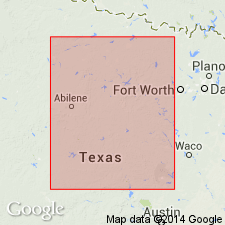
- Usage in publication:
-
- Pueblo formation
- Modifications:
-
- Original reference
- Dominant lithology:
-
- Limestone
- Sand
- AAPG geologic province:
-
- Bend arch
Summary:
Pg. 133-145. Pueblo formation of Cisco [group]. Bounded at top by Pueblo limestone [Camp Colorado limestone], which is yellow, fossiliferous, and impure. Near Red Bed line in Stephens County, central northern Texas, it changes to sand and loses its identity, but just below its horizon is a thin limestone abundant in MYALINA fossils [pelecypods], which characterize this bed. The members of this formation are so variable that no one section is typical. Underlies Moran formation and overlies Waldrip formation [now (ca. 1938) replaced by Harpersville formation]. [Age is Pennsylvanian.]
[Named from exposures along valley of Battle Creek at Pueblo, Callahan Co., Brazos River Valley, central northern TX.]
Source: US geologic names lexicon (USGS Bull. 896, p. 1739-1740).
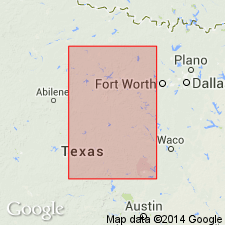
- Usage in publication:
-
- Pueblo formation*
- Modifications:
-
- Revised
- Dominant lithology:
-
- Limestone
- Shale
- Sandstone
- Chert
- AAPG geologic province:
-
- Bend arch
Summary:
Pg. 24, 31, 40. Pueblo formation of Cisco group. Largely gray, buff, or reddish shale, with Camp Colorado limestone (3 to 6 feet thick) at top and Camp Creek shale member at base. Thickness of formation 150 to 200 feet. Underlies Watts Creek shale member of Moran formation and overlies Harpersville formation, top member of which is Saddle Creek limestone. Age is Pennsylvanian. [This is present (ca. 1936) definition of the USGS.]
Source: US geologic names lexicon (USGS Bull. 896, p. 1739-1740).

- Usage in publication:
-
- Pueblo formation*
- Modifications:
-
- Revised
- AAPG geologic province:
-
- Bend arch
Summary:
Pg. 132-134. Pueblo formation of Wichita group. Includes (ascending) Camp Creek shale, Coon Mountain sandstone, Stockwether limestone, a series of shale beds with some sandstones and thin limestones, and Camp Colorado limestone members. Overlies Harpersville formation; underlies Moran formation of Wichita group. Age is Pennsylvanian.
Source: US geologic names lexicon (USGS Bull. 1200, p. 3149-3150).
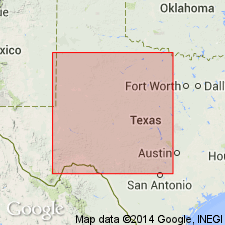
- Usage in publication:
-
- Pueblo group
- Modifications:
-
- Revised
- AAPG geologic province:
-
- Bend arch
Summary:
Pg. 66 (fig. 1), 91, 93. Pueblo group. Rank raised to group and expanded below to redefined Permian-Pennsylvanian boundary (Wolfcamp-Cisco) which is placed at disconformity in Harpersville formation above Waldrip-Newcastle coal zone about 40 to 150 feet below Saddle Creek limestone. As redefined includes (ascending) Saddle Creek, Stockwether, and Camp Colorado formations. Underlies Moran group; overlies Thrifty group (redefined).
Source: US geologic names lexicon (USGS Bull. 1200, p. 3149-3150).
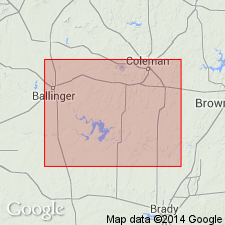
- Usage in publication:
-
- Pueblo formation*
- Modifications:
-
- Revised
- AAPG geologic province:
-
- Bend arch
Summary:
Sheet 2. Pueblo formation. Includes beds lying between disconformity at base of Waldrip shale and top of Camp Colorado limestone. Average thickness in southern Coleman County, central northern Texas, 225 feet. Comprises (ascending) Waldrip shale, Saddle Creek limestone, Camp Creek shale, Stockwether limestone, Salt Creek Bend shale, and Camp Colorado limestone members. Underlies Moran formation; overlies Pennsylvanian Cisco group. Age is Early Permian (Wolfcamp).
Source: US geologic names lexicon (USGS Bull. 1200, p. 3149-3150).
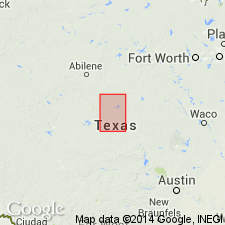
- Usage in publication:
-
- Pueblo formation*
- Modifications:
-
- Areal extent
- AAPG geologic province:
-
- Bend arch
Summary:
Pg. 75-76, pl. 27. Pueblo formation in Brown and Coleman Counties, central northern Texas, comprises (ascending) Waldrip shale, Saddle Creek limestone, Camp Creek shale, Coon Mountain sandstone, Stockwether limestone, Salt Creek Bend shale, and Camp Colorado limestone members. Overlies Chaffin limestone member of Thrifty formation. Only lower part of formation discussed in this report. [Age is Early Permian (Wolfcamp).]
Source: US geologic names lexicon (USGS Bull. 1200, p. 3149-3150).
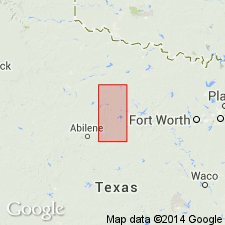
- Usage in publication:
-
- Pueblo formation*
- Modifications:
-
- Areal extent
- AAPG geologic province:
-
- Bend arch
Summary:
Pg. 276-270. Pueblo formation, in Brazos River Valley, comprises (ascending) Waldrip shale, Saddle Creek limestone, Camp Creek shale, Stockwether limestone, Salt Creek Bend shale, and Camp Colorado shale members. Thickness 275 to 400 feet. Overlies Chaffin limestone member of Thrifty formation; underlies Watts Creek shale member of Moran formation. Locally, Chaffin and underlying shale members of Thrifty are absent and Pueblo rests on rocks as old as Breckenridge member of Thrifty. Boundary between Pueblo and Moran not mapped north of Elm Creek (east-central Throckmorton and west-central Young Counties, northern central Texas); boundary difficult to discern because of probable absence of Camp Colorado limestone. [Age is Early Permian (Wolfcamp).]
Source: US geologic names lexicon (USGS Bull. 1200, p. 3149-3150).
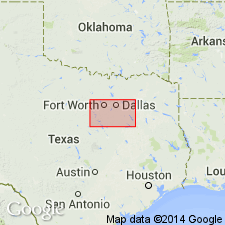
- Usage in publication:
-
- Pueblo Formation
- Modifications:
-
- Revised
- Mapped 1:250k
- Dominant lithology:
-
- Mudstone
- Shale
- Sandstone
- Siltstone
- Limestone
- AAPG geologic province:
-
- Bend arch
Summary:
Pueblo Formation of Cisco Group. Mudstone, shale, sandstone, siltstone, and limestone. Includes (descending) Salt Creek Bend Shale, Stockwether Limestone, Camp Creek Shale, and Saddle Creek Limestone [all unranked, shales not separately described]. Thickness 150 to 175 feet, thins northward. Underlies Moran Formation and overlies Harpersville Formation, both of Cisco Group. Age is Early Permian (Wolfcampian).
Mapped in Brown, Eastland, Shackelford, Stephens, and Young Cos., central northern TX.
[Camp Colorado Limestone is transferred to overlying Moran Formation; Waldrip Shale is transferred to underlying Harpersville Formation.]
Source: Publication.
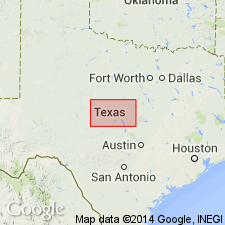
- Usage in publication:
-
- Pueblo Formation
- Modifications:
-
- Mapped 1:250k
- Dominant lithology:
-
- Shale
- Sandstone
- Siltstone
- Limestone
- AAPG geologic province:
-
- Bend arch
- Llano uplift
Summary:
Pueblo Formation of Cisco Group. Shale, sandstone, siltstone, and limestone. Includes (descending) Salt Creek Shale, Stockwether Limestone, Camp Creek Shale, Coon Mountain Sandstone [local], and Saddle Creek Limestone [all unranked]. Thickness 160 to 214 feet, thins northward. Underlies Moran Formation and overlies Harpersville Formation, both of Cisco Group. Age is Early Permian (Wolfcampian).
[Mapped in Brown, Coleman, and McCulloch Cos., central TX.]
Source: Publication.
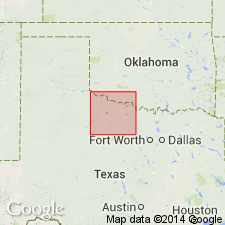
- Usage in publication:
-
- Pueblo Formation
- Modifications:
-
- Revised
- Mapped 1:250k
- Dominant lithology:
-
- Mudstone
- Sandstone
- AAPG geologic province:
-
- Bend arch
Summary:
Pueblo Formation of Cisco Group. Mudstone and sandstone; mostly mudstone, tan, gray, maroon, green, poorly exposed; a few thin sandstone beds, tan, very fine-grained, laminated, ripple-marked, locally calcareous and burrowed. Terminated by stratigraphic cutoff immediately north of southern border of area shown on Wichita Falls-Lawton sheet; best exposed in area depicted on adjacent Abilene sheet. Thickness of Pueblo Formation (revised) 150 to 170 feet. Underlies Moran Formation and overlies Harpersville Formation, both of Cisco Group. Age is Early Permian (Wolfcampian).
Source: Publication.
For more information, please contact Nancy Stamm, Geologic Names Committee Secretary.
Asterisk (*) indicates published by U.S. Geological Survey authors.
"No current usage" (†) implies that a name has been abandoned or has fallen into disuse. Former usage and, if known, replacement name given in parentheses ( ).
Slash (/) indicates name conflicts with nomenclatural guidelines (CSN, 1933; ACSN, 1961, 1970; NACSN, 1983, 2005, 2021). May be explained within brackets ([ ]).

